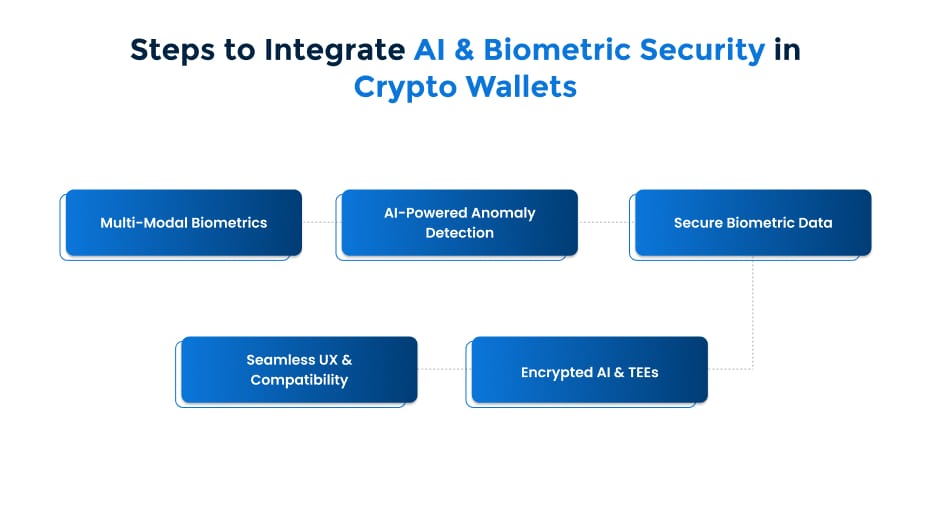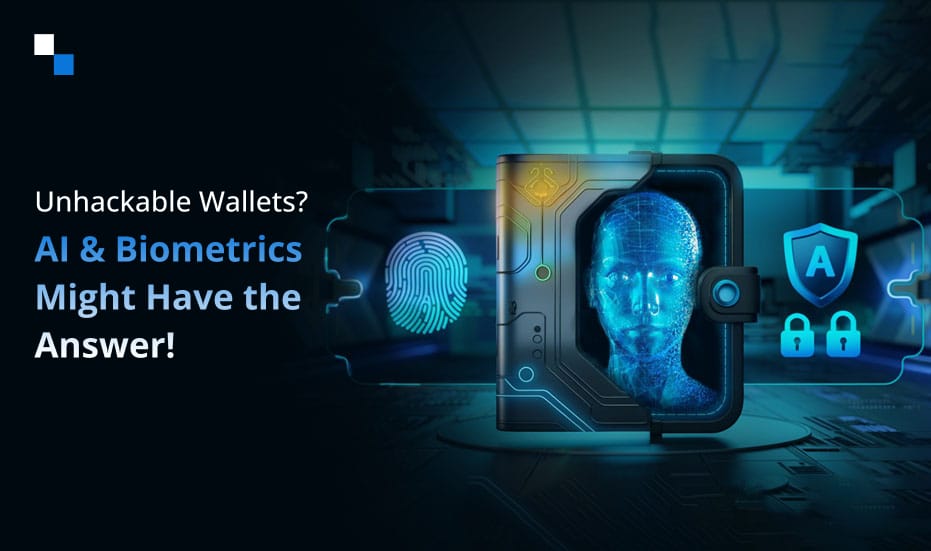
Multi-Chain Success Starts Now—Integrate Chain Abstraction into Your White-Label DEX!
February 27, 2025
Innovative AI Strategies for T2E Game Development: A Business Guide
February 27, 2025Table Of Content
- Understanding the Security Landscape in Crypto Wallet Development
- How Do AI & Biometrics Work Together to Fortify Crypto Wallet Security?
- AI: The Intelligent Guardian of Crypto Wallets
- Biometric Authentication: The Unbreakable Key
- Overcoming Challenges in AI-Biometric Crypto Wallet Integration
- Core Features of AI & Biometric-Integrated Crypto Wallets
- How to Successfully Integrate AI & Biometric Authentication in Crypto Wallet?
- How Much Does AI & Biometric-Integrated Crypto Wallet Cost?
- Future Nexus: The Convergence of AI, Biometrics & Crypto Security
- Secure Your Crypto Wallet with Antier’s AI & Biometrics
For years, crypto wallets have relied on passwords and seed phrases—methods that, while effective, remain vulnerable to phishing, leaks, and brute-force attacks. But what if your wallet could recognize you—not just your credentials?
AI-driven authentication and biometrics are reshaping security.Wallet development can offer a seamless, hacker-resistant experience by leveraging machine learning to detect suspicious activity and biometric data to confirm identity. Imagine a system that adapts to your usage patterns, rejecting any attempt that deviates from your normal behavior.
Is this the long-awaited answer to crypto security concerns? Or are there challenges that still need to be addressed? Let’s dive in.
Understanding the Security Landscape in Crypto Wallet Development
The security landscape in crypto wallet development is a complex interplay of cryptographic integrity, decentralized frameworks, and advanced threat mitigation techniques. While blockchain’s immutability provides a secure ledger foundation, wallet endpoints remain high-value targets for adversaries leveraging attack vectors such as phishing, side-channel exploits, and private key extraction via sophisticated malware. Traditional security measures, including deterministic key generation and HD wallets, are being reinforced with next-gen cryptographic primitives like threshold signatures (TSS) and MPC to minimize single points of failure. Additionally, hardware security modules (HSMs) and TEEs are being leveraged to safeguard private key operations at the hardware level.
The advent of AI-driven anomaly detection, coupled with biometric authentication, is transforming static security postures into adaptive, self-learning defense mechanisms. Enterprises must integrate post-quantum cryptography (PQC) to future-proof wallet development infrastructures against emerging attack surfaces as quantum threats loom. AI-driven anomaly detection and biometric verification create a multi-layered security framework that continuously evolves to counter sophisticated cyber threats. This synergy strengthens authentication and enhances fraud prevention. So, how do these technologies collectively reinforce crypto wallet security?
How Do AI & Biometrics Work Together to Fortify Crypto Wallet Security?
Conventional authentication methods are no longer sufficient against advanced cyber threats. AI and biometric authentication work in tandem, providing an intelligent, adaptive security framework to combat this. This synergy strengthens protection and enhances user experience by eliminating friction while maintaining robust security. For clear understanding, let’s explore their role individually:
AI: The Intelligent Guardian of Crypto Wallets
AI plays a pivotal role in securing crypto wallet development by identifying threats before they can inflict damage. AI continuously monitors user activity, detecting anomalies that may indicate fraudulent access attempts by leveraging machine learning and behavioral analytics.
Key AI-driven security mechanisms include:
- Behavioral biometrics – AI examines keystroke dynamics, mouse movements, and touch gestures for authentication.
- Adaptive authentication – Security layers adjust dynamically based on real-time risk analysis.
- Fraud detection in transactions – AI flags unusual transaction patterns, preventing unauthorized withdrawals.
These advancements make cryptocurrency wallet app development more resilient against phishing, malware, and credential-stuffing attacks, ensuring unparalleled security.
Biometric Authentication: The Unbreakable Key
Biometric authentication eliminates reliance on vulnerable passwords, linking wallet access to an individual’s unique biological traits. Fingerprint scanning, facial recognition, and voice authentication strengthen security while improving user experience.
Core biometric security enhancements include:
- Multi-modal authentication – Using multiple biometric methods for layered protection.
- Liveness detection – Preventing deepfake and spoofing attacks through real-time biometric validation.
- Decentralized identity verification – Enhancing privacy by eliminating centralized data storage vulnerabilities.
Enterprises can offer cutting-edge security without compromising accessibility by integrating biometrics into wallet development services. The fusion of AI & biometrics is redefining crypto wallet development services, ensuring an ecosystem where digital assets remain untouchable by cyber threats.
The path to seamlessly combining AI with biometric authentication isn’t without its challenges, including data privacy concerns and system reliability. However, with the right strategies, enterprises can overcome these obstacles and unlock the true potential of secure, user-friendly crypto wallets.
Overcoming Challenges in AI-Biometric Crypto Wallet Integration
Imagine logging into your crypto wallet with just a glance or a fingerprint. AI biometrics make this possible, but it’s not without its hurdles. Let’s take a look at the challenges and the clever solutions that are making this technology safer and more accessible.

By addressing these challenges with tailored solutions, enterprises can ensure secure, scalable, and efficient AI-biometric authentication in crypto wallets. This unlocks a new level of security while optimizing user experience. Now, let’s dive into the core features that make AI and biometric integration essential for the future of crypto wallets.

Core Features of AI & Biometric-Integrated Crypto Wallets
Enterprises eager to build wallets integrated with AI and biometric systems must prioritize the following features, ensuring their solutions remain secure, innovative, and highly engaging for users.
1. AI-Driven Fraud Detection : AI-powered algorithms continuously analyze transaction data to detect suspicious activities in real time. Such cutting-edge technology makes crypto wallet development services indispensable for enterprises looking to future-proof their offerings.
2. Biometric Authentication : Incorporating biometric features like fingerprint scanning, facial recognition, and retina identification provides unmatched security for crypto wallets. This integration allows for swift access, offering users the peace of mind that only authorized individuals can unlock their funds.
3. Smart Transaction Suggestions : AI-driven insights can help users make better financial decisions by recommending optimal transaction strategies. This predictive capability assists in improving the wallet’s overall functionality, making cryptocurrency wallet app development a game-changer in the space.
4. Real-Time Encryption : AI constantly adjusts encryption methods based on emerging threats, ensuring that all transactions remain secure. This layer of protection is vital for maintaining trust and safeguarding sensitive user data across various platforms.
5. Adaptive Authentication Methods : AI can implement MFA protocols tailored to each user’s behavior and environment. The system adapts to offer seamless yet secure access by using contextual data, such as location or device.
6. Automated Portfolio Management : AI’s portfolio management capabilities help users keep track of their digital assets, offering real-time market analysis and assisting with automated trades. Enterprises seeking advanced cryptocurrency wallet app development services can leverage AI for enhanced wealth management.
7. Seamless Multi-Currency Support : AI ensures seamless integration and management of multiple cryptocurrencies within a single wallet, optimizing the user experience while expanding the wallet’s potential for future scalability.
8. User Behavior Analytics : AI enhances the wallet’s interface, providing tailored suggestions and improved usability by tracking user habits. This constant feedback loop strengthens user engagement, ensuring that each interaction is intuitive.
Integrating AI and biometric systems will redefine the security and functionality of digital wallets, catering to both enterprises and users with unparalleled innovation with the advancement of crypto wallet development services.
How to Successfully Integrate AI & Biometric Authentication in Crypto Wallet?

AI-driven biometrics is redefining security in crypto wallet development services, offering enterprises and fintech innovators an unassailable defense against cyber threats. Here’s a stepwise guide to integrating AI-powered biometric authentication in a sophisticated and seamless way.
- Multi-Modal Biometrics : Deploy an advanced authentication matrix combining fingerprint, facial, and iris recognition. This redundancy in identity verification ensures ironclad protection, enhancing security layers in cryptocurrency wallet app development.
- AI-Powered Anomaly Detection : Your wallet can detect and thwart unauthorized access attempts before they escalate with AI-driven behavioral analytics. AI prevents fraudulent transactions in real time by learning user habits.
- Secure Biometric Data : Storing biometric data in centralized servers invites risk. Instead, implement cryptographic hashing and decentralized identity solutions to ensure biometric credentials remain immutable and confidential.
- Encrypted AI & TEEs : TEEs safeguard AI computations, preventing data exposure during authentication processes. This layered security model enhances wallet development services, shielding biometric data and AI-driven authentication algorithms.
- Seamless UX & Compatibility : AI-enhanced biometric authentication should not introduce friction. A well-integrated system ensures fluid user experiences while maintaining top-tier security, making high-end wallet solutions both elite and accessible.
AI-driven biometric security is the key differentiator for next-generation wallets. As financial threats grow more sophisticated, only those who embrace AI-powered authentication will remain ahead of the curve. But with such cutting-edge security, one pressing question remains—what does it cost to integrate AI & biometric authentication into a crypto wallet?
How Much Does AI & Biometric-Integrated Crypto Wallet Cost?
The cost of developing an AI and biometric-integrated crypto wallet is influenced by multiple factors, including security architecture, AI-driven authentication systems, and compliance with regulatory frameworks. Building a next-gen wallet demands robust crypto wallet development services, where biometric authentication—ranging from fingerprint recognition to advanced facial and iris scanning. The complexity of AI-driven anomaly detection significantly impacts development expenses. Implementing machine learning models to analyze user behavior, detect fraud, and enhance real-time security requires sophisticated algorithms and computing power.
Additionally, cryptocurrency wallet app development involves securing biometric data with encryption standards like homomorphic encryption, zero-knowledge proofs, and decentralized identity solutions, further influencing costs. Moreover, wallet development services must optimize the user experience without compromising security, necessitating seamless compatibility across multiple platforms and devices. Ultimately, the investment required depends on the level of customization, security sophistication, and compliance requirements. Enterprises seeking to develop a future-proof AI-biometric wallet must carefully evaluate these elements to ensure a balance between innovation, security, and cost efficiency.
Future Nexus: The Convergence of AI, Biometrics & Crypto Security
The fusion of AI and biometric authentication is set to redefine cryptocurrency wallet security, ushering in a new era of trustless, self-sovereign identity management. At the core of this transformation lies Decentralized Identity (DID) solutions, empowering users with complete control over their digital identities without reliance on centralized entities. DID systems enhance privacy, mitigate data breaches, and eliminate single points of failure by leveraging blockchain-based decentralized identifiers.
Advanced cryptographic techniques, such as zero-knowledge proofs, enable secure, private authentication, ensuring sensitive information remains undisclosed. Meanwhile, cutting-edge biometric innovations—including palm-scanning and iris-recognition systems—are shaping the future of digital identity verification, reinforcing wallet security with unparalleled precision. As AI-driven anomaly detection fortifies fraud prevention, the seamless convergence of AI, biometrics, and DID solutions is poised to define the next frontier of secure digital transactions.
Secure Your Crypto Wallet with Antier’s AI & Biometrics
Antier, a renowned crypto wallet development company, specializes in developing next-generation crypto wallets fortified with AI-driven security and biometric authentication. Our crypto wallet development services integrate multi-modal biometrics, ensuring seamless yet highly secure access. We leverage AI-powered fraud detection to identify anomalies in real time, preventing unauthorized access and cyber threats. Our expertise extends to cryptocurrency wallet app development, where we implement DID solutions for self-sovereign identity control. Partner with a leading crypto wallet app development company like Antier to build an AI-enhanced, biometric-secured crypto wallet that sets new industry standards.



